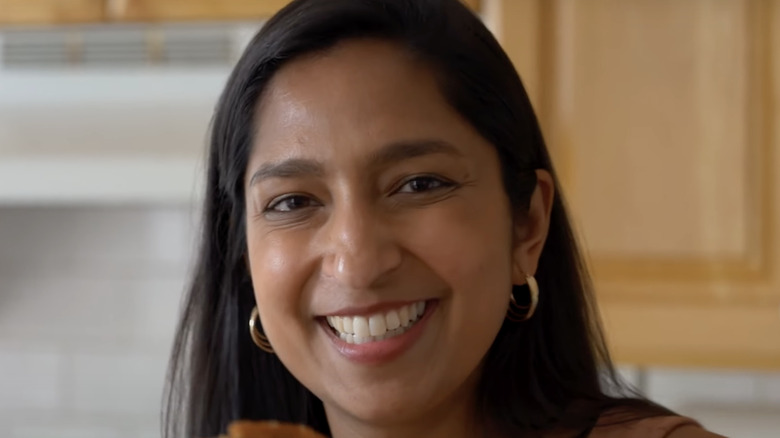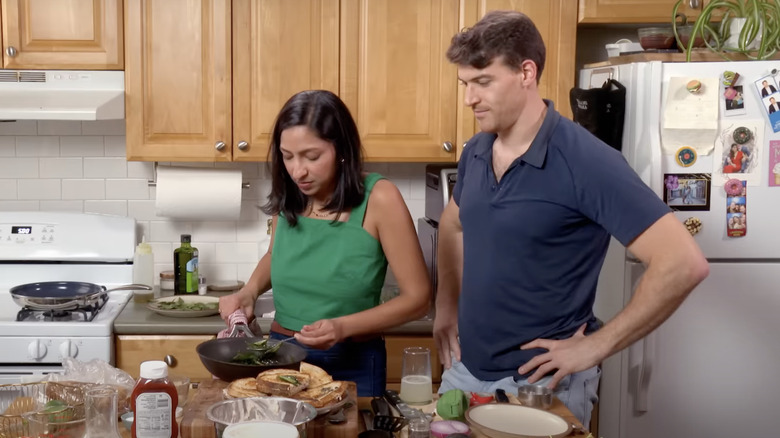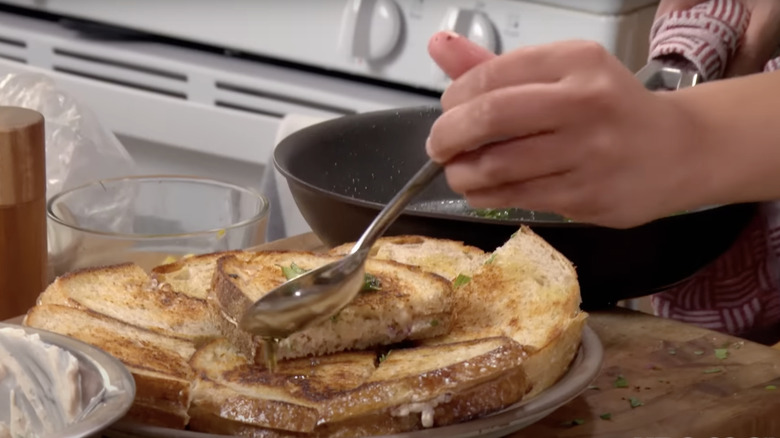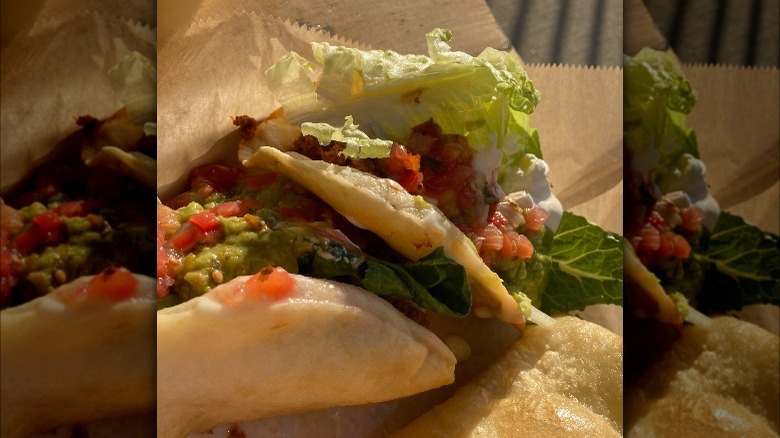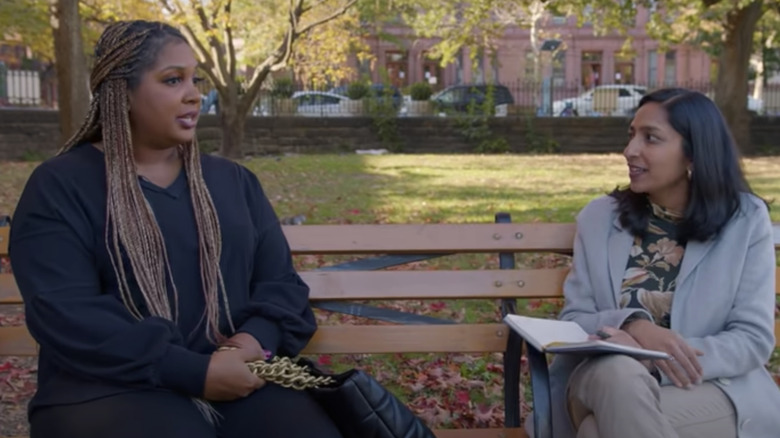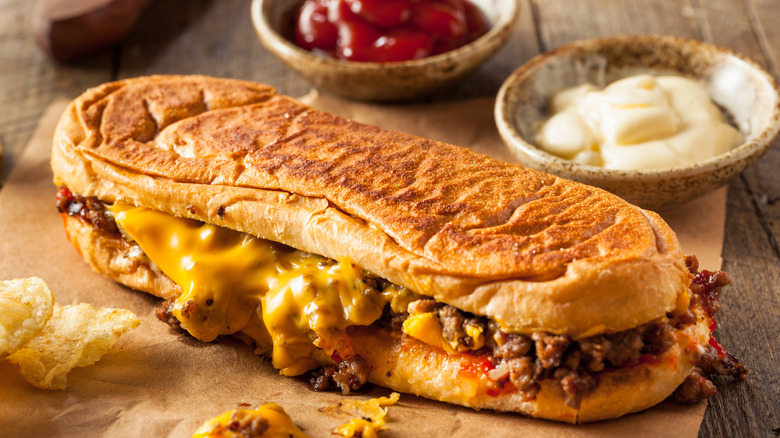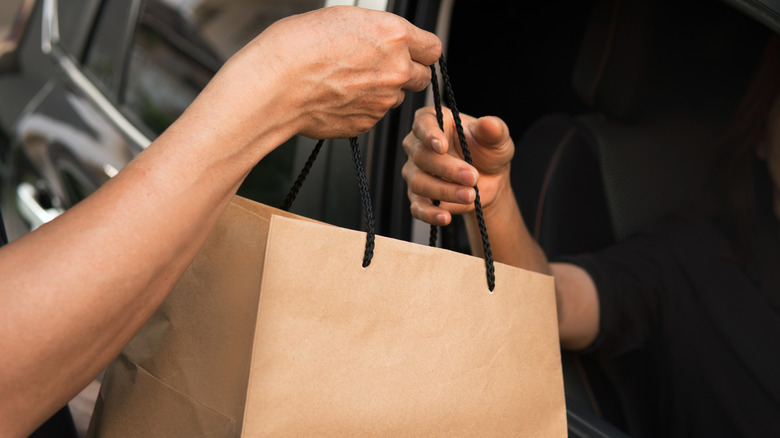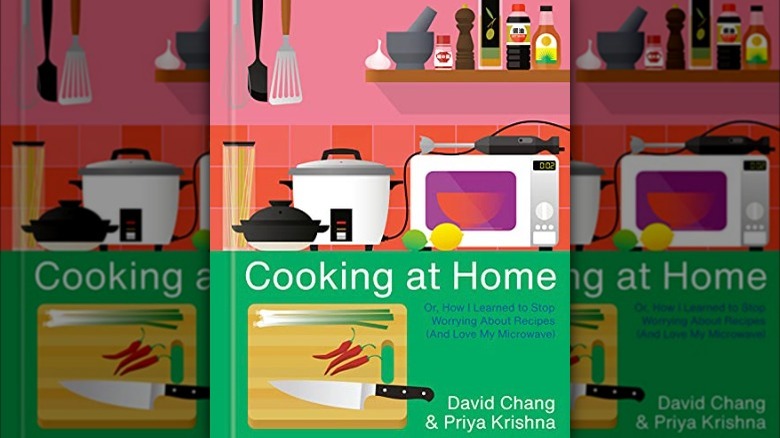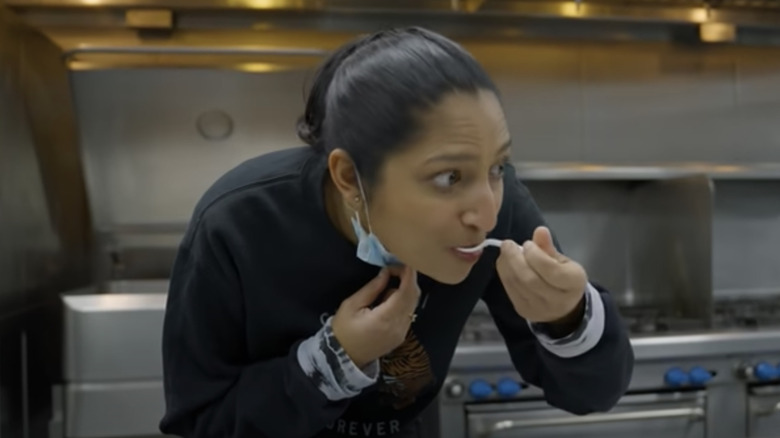Priya Krishna Talks Selena + Chef, Puffy Tacos, And Why Microwaves Are Underrated - Exclusive Interview
We may receive a commission on purchases made from links.
Priya Krishna is a major force in the world of food media. She creates recipes, does investigative journalism, writes, and hosts videos. Per Krishna's website, she began her career at David Chang's now-defunct magazine, "Lucky Peach." She published her first cookbook, a guide for how to cook meals using ingredients commonly found in college dining halls, called "Ultimate Dining Hall Hacks," in 2014. Her 2019 cookbook, "Indian-ish," is a collection of Indian-inspired recipes as well as a celebration of her family. It earned accolades from The New York Times and Bon Appétit.
These days, Priya works as a columnist for The New York Times, writing in-depth stories about a wide variety of food-related topics. She also hosts a YouTube series for the company, called "On the Job."
Recently, Priya was the featured chef on an episode of Selena Gomez's HBO Max cooking show, "Selena + Chef." On the show, she taught Gomez how to cook an Indian sandwich called dahi toast. Krishna sat down with Mashed for an exclusive interview to talk about her experience teaching Selena how to cook and to share many other stories from her wide-ranging career.
What it's like to appear on Selena + Chef
Every chef on "Selena + Chef" picks a charity to highlight. Can you share a little bit about the charity you picked?
I picked my local mutual aid organization, South Brooklyn Mutual Aid. I feel like the world of charity and nonprofits can be overwhelming, and a good way to start is in your own community. I live in South Brooklyn and have volunteered with South Brooklyn Mutual Aid doing translation work at COVID vaccination centers and thought it would be nice to help out the neighborhood where I live.
On the show, you teach Selena Gomez how to cook over a video call. What's it like trying to teach someone how to cook on Zoom?
It was really fun. The way that I cook, I try not to be too chef-y, too precious, too much into, "You have to add exactly this amount of this" or "exactly this amount of that." What I was trying to instill on set or over Zoom was a sense of, "You add a little more of this; you add a little less of this. It's all going to be okay." I think this is how a lot of people cook. They use recipes as guidelines. They don't think about it too much like an exact science.
[With] what I'm making, we're not baking; we're not laminating dough; we're not making croissants. I hope Selena took away that with the way I cook, you don't have to be staring at me and precisely following my steps over Zoom. I hope that translated and made it easier to cook over Zoom.
Teaching Selena Gomez how to cook dahi toast
Is she a quick study in the kitchen?
She is. She really is. Of course, there are some times where I would maybe do a step a little bit too fast and she would miss it and I would do it again. But Selena does not give herself enough credit. She did a fantastic job. Her dahi toast looked awesome.
How did you pick the menu that you demonstrated on the show?
What they told me was to think of something summery and something comforting, and my ultimate comfort food is dahi toast. It is basically better than a grilled cheese sandwich. [It's] a jazzed-up, hot, filled sandwich with tempered spices on top, and I eat it with ketchup and chutney swirled together. It feels like an ideal summer meal. You have it with a nice shikanji, which is this amazing salt and lime and peppery drink that I grew up drinking in Dallas.
It's easy and unfussy and portable and refreshing, and those are the things that I look for in summer comfort food. I also watched the show, and I was thinking about what things she would like. I feel like she doesn't like the super fancy, fussy food. So I was like, "What's something that's simple and unfussy and just essentially delicious?" And dahi toast was the first thing that came to mind.
Why San Antonio and Dallas are great food cities
On Instagram, you recently said that San Antonio might be your favorite city in America. What makes San Antonio so special?
I love that San Antonio is like this agricultural bread basket. It has a city feel, but you also feel like you're in nature. It's incredible that the River Walk runs right through the city and you see people kayaking and paddleboarding on it. I feel like it's rare that a city gives you [a] natural feel and [an] urban feel in the same place. I love San Antonio.
What's your favorite food there?
I know that it's at this point very overhyped, but I love puffy tacos in San Antonio. I think they're delicious. What's not to love about that?
There's a certain similarity between those and some Indian flatbread dishes as well, perhaps.
That wasn't the first connection I made. I just thought, "This is a brilliant, brilliant idea." The first time I had a puffy taco, I dreamt about it. But there's so many incredible things to eat in San Antonio.
You grew up in the Dallas area. If there's one thing you'd want people to know about Dallas who aren't very familiar with the town, what would you like to share?
Dallas is a city of immigrants, and that's reflected in our food scene. We have Indian restaurants because we have a big South Asian population. We have an incredible Vietnamese food scene. You're even starting to see more Laotian restaurants come up. My favorite restaurants in the city are the ones that are reflective of that diversity. It's been awesome to see the city grow more diverse every year.
Filming 'On the Job'
You host a YouTube series for The New York Times called "On the Job," which covers the under-seen corners of the food industry. What inspired you to start making films about that topic?
I think about who gets to be profiled in food media, and oftentimes it's the chef of a restaurant, and there are so many people that make our food industry run who maybe don't get that same shine that, say, a chef does. The work they do is hard and fascinating, and I think people would benefit from understanding that work visually through a video.
For example, one of the episodes we did was about what happens to the laundry at restaurants. The sheer amusement-park setup that is a restaurant laundry operation is absolutely incredible. This service is literally indispensable. The restaurant industry cannot run without clean laundry. You look at everything it takes just to get a clean napkin out to a restaurant, and that is fascinating. I think that's worth celebrating and applauding and spotlighting in the same way that we have spotlighted a chef who can put out a really amazing plate of food.
Is there one moment you can pick that sticks out to you from filming that show?
There are so many moments that stand out. But one overarching thing that I'm amazed by is that a lot of these people that I interviewed don't believe their job to be hard, even though it is. These are some of the hardest jobs I've ever encountered. They are oftentimes thankless jobs, but these are very much people who are putting their heads down and getting it done. It reinforced my desire to want to spotlight these people.
We spoke to Lyana from Black Rican Vegan, and she was explaining how she literally grocery shops, she does social media, she cooks, she cleans, she does everything. She was like, "Yeah, I guess that is hard." And I was like, "Yes, it is hard. Acknowledge that your job is hard and that you are crushing it."
Priya's ultimate bodega sandwich
One thing you did on the show was visit Rahim Mohamed's TikTok-famous bodega, and he dreamed up a special for you. If it was left up to you, what would be your own "Ocky Way" sandwich?
Probably a variation on a chopped cheese. I love chopped cheeses. I think they're absolutely delicious.
For the last couple of years, you and your husband, Seth, have competed against Sohla and Ham El-Waylly in these epic gingerbread house battles. They seem very stressful! If you do it again, have you learned anything that'll be helpful for next time?
To not bite off more than you can chew. I feel like every year we have these grand plans, and those grand plans would require approximately 10 days to execute. This year I want to do something that is equally dazzling and exciting but manageable, that doesn't require us staying up the whole night the previous night to get it done.
Why cooks are opening restaurants in nontraditional ways
In your work for The Times, you've covered a lot of food businesses opening in unexpected ways, like great restaurants opening in the suburbs or bánh mì places running drive-thrus or the restaurant that runs on Instagram that you mentioned. Why do you think food businesses are choosing these non-traditional paths so much?
A lot of it has to do with access to resources. Opening a restaurant is an incredibly capital-intensive thing. It requires investors. It requires access to designers, contractors, and architects. Not everyone has that. You figure out how to serve delicious food with the resources you do have, and you make strategic decisions, like, "I think people in this suburb are going to love my food, and it happens to be less expensive to open there." It really does come down to the fact that to open a restaurant, it often costs an insane amount of money.
Do you think it's a positive development that people who wouldn't necessarily have the resources to open a traditional restaurant can now find these alternative paths?
Yes. I often like to say [about] some of the best chefs in the world, we'll never get to eat their food because they don't have the resources to start a restaurant. If we are building these pathways to make it more accessible for someone to serve their food in the public sphere, I am all for it.
Writing Cooking at Home with David Chang
Switching gears a little bit, last year you wrote a book with David Chang called "Cooking at Home." How did that collaboration come about?
Dave and I met because I used to work for Lucky Peach, which was owned by Momofuku.
What was the process like when you were working on that book?
It was really hard because Dave basically told me right off the bat, "I want to write a book without recipes. I want to teach people to be more intuitive cooks." So I was teaching myself how to be a more intuitive cook. I was basically putting myself in the shoes of the reader and being like, "How can I write an actually useful cookbook that isn't just contrarian for the sake of being contrarian?" It was a lot of me cooking at home, me watching Dave, [and me] learning to trust myself on, like, how much soy sauce is the right amount of soy sauce to add?
A lot of it was really scary. I don't do a lot of braising meats at home. I was cooking a lot of things that I had never cooked for the first time. But the conversation between me and Dave, between him being like, "Let's challenge traditional cooking orthodoxy," and me being like, "Okay, but let's make it actually useful," made the book better. It turned out to be a really nice book.
It's sort of like what you talked about when you were teaching Selena, that you're trying not to be too precious about exactitude.
Exactly.
"Cooking at Home" celebrates the microwave. What's your favorite recipe that's unexpectedly great to cook in the microwave?
You can make mashed potatoes in the microwave. Mashed potatoes are really easy: You just microwave the potatoes, then add cream, olive oil, and herbs. The microwave gives you the silkiest mashed potatoes ever.
Priya's favorite chef, ingredient, and fast food
What chef — or [home] cook — it doesn't have to be a chef — would you like to cook dinner for you?
What a great question. I would love to have someone cook me dinner. ... There are so many people who I'd like to cook me dinner. I don't know if these people would want to cook me dinner, though. ...
My friend Kushbu, she's always taking photos of what her parents make her at home, and I would love for Kushbu's mom to make me dinner. I think it'd be fantastic.
You've never gotten to eat her food?
I've never gotten to eat her food, but it looks amazing.
What's one ingredient that you can't live without?
There are so many ingredients I can't live without. Cumin seeds go in so much of what I cook with.
Is that specifically cumin seed rather than ground cumin?
Yes, definitely. The seed. I love the texture of the whole seeds.
That little pop of crunch?
Yeah, it's really different from ground cumin.
If you eat fast food, what's your favorite spot, and what's your go-to order there?
Popeyes' fried chicken sandwich or [the] Taco Bell Seven-Layer Burrito. They don't always have the Seven-Layer. They may have even discontinued the Seven-Layer Burrito, but you can hack it.
Priya Krishna's episode of "Selena + Chef" debuts on HBO Max on September 1. Her cookbooks are available on Amazon.
This interview has been edited for clarity.
